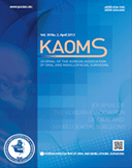Journal of the Korean Association of Oral and Maxillofacial Surgeons
- P-ISSN2234-7550
- E-ISSN2234-5930
- SCOPUS, KCI, ESCI
 ISSN : 2234-7550
ISSN : 2234-7550
Clinical significance of drug cessation on medication-related osteonecrosis of the jaw in patients with osteoporosis
Mi Young Eo (Department of Oral and Maxillofacial Surgery, Dental Research Institute, School of Dentistry, Seoul National University, Seoul, Korea)
Ju Young Lee (Department of Oral and Maxillofacial Surgery, Dental Research Institute, School of Dentistry, Seoul National University, Seoul, Korea)
Mi Hyun Seo (Department of Oral and Maxillofacial Surgery, Dental Research Institute, School of Dentistry, Seoul National University, Seoul, Korea)
Soung Min Kim (Department of Oral and Maxillofacial Surgery, Dental Research Institute, School of Dentistry, Seoul National University, Seoul, Korea)
Abstract
Objectives: Suspending bisphosphonates (BPs) to reduce the risk and severity of medication-related osteonecrosis of the jaw (MRONJ) remains controversial. In this study, we quantitatively evaluated the clinical significance of BP suspension before surgery in osteoporosis patients with MRONJ. Materials and Methods: We analyzed 24 osteoporosis patients with MRONJ who were treated from 2012 to 2020 at Seoul National University Dental Hospital and compared the treatment outcomes of those who suspended BPs with those who did not. The number of surgical interventions, follow-up panoramic radiographs for relative bone density measurement, and laboratory blood tests including white blood cells, erythrocyte sedimentation rate, absolute neutrophil count, hemoglobin, hematocrit, and alkaline phosphatase were analyzed. ANOVA, Student’s t -test, and Mann–Whitney U tests were used to compare results. Fisher’s exact test was used to discover the association between treatment outcome and BP suspension, and Pearson’s correlation test was used to measure the statistical relationship between the changes in serum inflammatory markers. Results: The number of interventions was significantly higher in the non-drug suspension group due to recurrence (P<0.05). The relative bone density in patients who suspended BPs was significantly different over time (P<0.05), with the highest density at one-year follow-up. Fisher’s exact test shows an association between successful treatment outcomes and BP suspension. The alkaline phosphatase and erythrocyte sedimentation rate levels decreased significantly in the BP-suspended group, and a positive correlation was found between these elevated markers. Conclusion: A significant increase in bone density throughout follow-up and a lower number of interventions were found in the BP suspension group compared to the non-drug suspension group. Also, BP suspension decreased inflammatory markers in the serum after surgery, resulting in good treatment outcomes. BP suspension is a prognostic factor for MRONJ and should be implemented before surgery.
- keywords
- Bisphosphonate-related osteonecrosis of the jaw, Bone density, Drug holiday, Inflammatory marker, Osteoporosis
- 다운로드 수
- 조회수
- 0KCI 피인용수
- 0WOS 피인용수